A dedicated arm day just hits different. Arm workouts may be a little less mentally taxing than a hard squat session but a true gun run can leave you feeling just as great. Walking away with a sweet pump and the endorphins flowing from a hard workout is arguably the best result you could ask for.
If you weren’t already incentivized, take note — a good arm day doesn’t even need much equipment. You can park yourself in front of a cable stack and go to town.
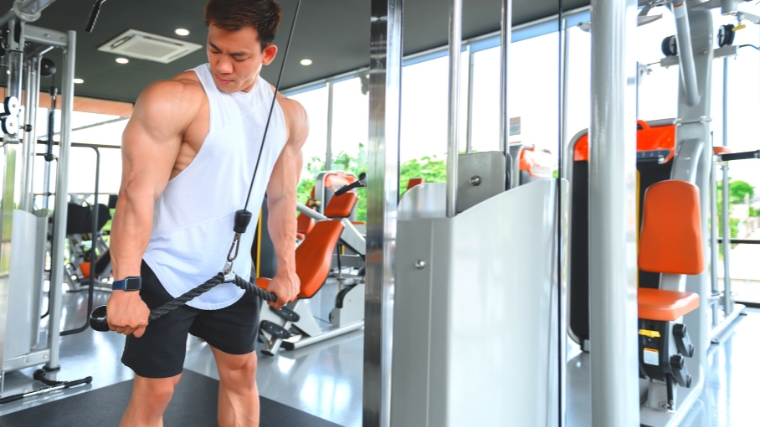
Every little detail needed to smoke your arms as effectively as possible can be accomplished by using a good cable system. Add some serious size to your pipes by trying these cable arm workouts.
Best Cable Arm Workouts
- Cable Arm Workout for Beginners
- Cable Arm Workout for Intermediates
- Cable Arm Workout for Advanced Lifters
Cable Arm Workout for Beginners
Setting the stage for long term arm gains is a great mindset to arrange your beginner sessions around. Selecting exercises that will synergize with potential sticking points later can help you make long-term progress. Qualities like grip strength, endurance, and a bit of bodily coordination are great to develop in your early years alongside some impressive arm gains.
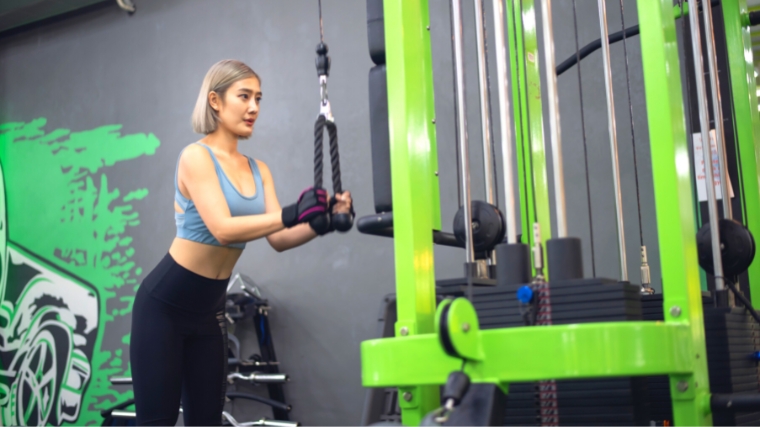
The Workout
The tragic reality of many arm days is that certain aspects of training can get in the way of your growth. Every arm exercise starts quite literally in your hands — if you can’t hold on to the implement long enough for your arms to reach failure, that’s a problem.
Choosing exercises such as a high-repetition hammer curl can build a strong foundation of grip, work capacity, and muscle growth.
- Rope Attachment Cable Hammer Curl: 3 x 15
- EZ-Bar Triceps Pushdown: 3 x 12
- Single-Arm Face-Away Cable Biceps Curl: 2 x 12-15 per arm
- Single-Arm Cable Triceps Pushdown: 2 x 12-15 per arm
Note: Embrace the burn during these beginner workouts. Getting close to failure during the high-repetition work will set the table for future success.
Cable Arm Workout for Intermediates
Beginner workouts should be designed around exercises that build your arms more generally, capturing as many different benefits as possible. As you enter an intermediate experience level, adding in more exercises and specific angles of attack can be very beneficial.

You’re now at the stage where extra volume and more specific exercises can help carve out more detail in your ever-expanding arms.
The Workout
Any good arm exercise you perform will engage either your biceps or triceps, sure. However, choosing the right exercise can subtly help shift some of the challenge to specific areas of those muscles (or their surrounding tissues). Training with your arm over your head for example will help target the long head of your triceps for a fuller look.
- Single-Arm Rope Cable Hammer Curl: 3 x 10-12 per arm
- Single-Arm Cable Triceps Pushdown: 3 x 10-12 per arm
- EZ-Bar Cable Biceps Curl: 3 x 10
- Single-Arm Overhead Cable Triceps Extensions: 3 x 12-15 per arm
Cable Arm Workout for Advanced Lifters
Once you have years of solid training under your belt, driving progress forward will depend on your attention to detail and pain tolerance more than anything else. With more experience, you can now start to mix in different repetition ranges that best suit specific exercises.
You can also start playing with intensification techniques to really push yourself to — and beyond — muscular failure.
The Workout
Start with some higher-repetition, highly isolated exercises to achieve a savage pump. From there, add in some heavier, more stable exercises to apply tons of mechanical tension to your already-engaged biceps and triceps.
Finally, crush your biceps and triceps with some intensifiers to make sure you can’t lift your arms overhead for the rest of the day.
- High Cable Biceps Curl: 2 x 15-20 repetitions
- Cable Cross-body Triceps Extensions: 2 x 15-20 repetitions
- EZ-Bar Preacher Curl: 3 x 8-10 repetitions
- EZ-Bar Triceps Pushdown: 3 x 8-10 repetitions
- Face-Away Incline Cable Biceps Curls: 3×12–15 repetitions w/ added drop set
- Single-Arm Overhead Cable Triceps Extensions: 3×12–15 repetitions w/ added drop set
Note: Perform a drop set on the final set of both the face-away incline cable biceps curls and the single-arm overhead cable triceps extensions if you want to really take your arms to the limit.
How to Progress Cable Arm Workouts
Progressing your cable workouts may require some unique strategies, especially for a muscle group like the arms. Cables lack the straightforward loading capability of the barbell, so you’ll probably have to get creative. q
For the arms, changing up your repetition schemes, changing out certain implements, and pursuing progressive overload are great choices.
Change Your Repetitions
You can build substantial muscle across a variety of repetition ranges as long as you keep your intensity high. (1) With that in mind, some exercises or muscle groups can be harder to stimulate than others with certain repetition schemes.
Lower repetition ranges usually come with heavier actual loads; however, going heavy may challenge your ability to maintain sound technique. As such, lifting extra-heavy weights across low rep ranges with smaller muscle groups (like the arms) might be a bit too challenging to produce meaningful results.
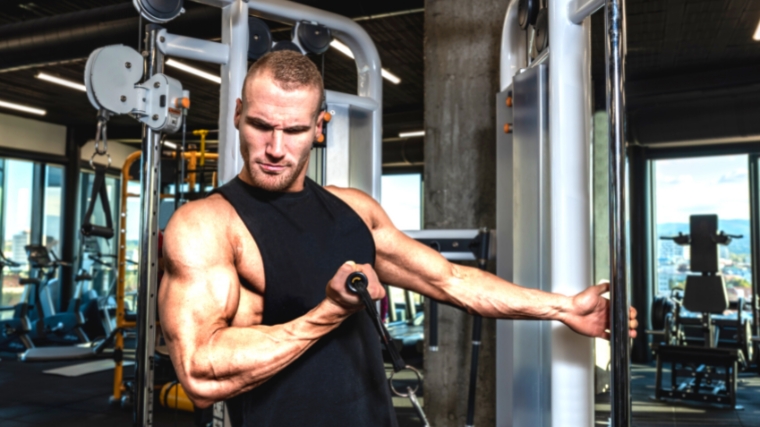
Instead, start with higher repetition sets before slowly increasing the load over time. Make sure you are always reaching high intensity (getting close to failure) with good technique as a priority. Once you can bang out high-quality sets of more than 15 reps, then consider upping the weight.
Change Your Implement
Cables are unique in the weight room because they often come with multiple choices of grip or implement for any exercise. For example, a rope attachment or a standard D-handle can both be used to stimulate the biceps, but are less-stable options than an EZ-Bar attachment.
Once you’ve hit a plateau on how much you can stimulate your arms with unilateral implements, switching it up by adding in some easier-to-control implements can be a huge boost. Going from curling with a rope attachment to a straight bar can make more of a difference than you’d expect.
Progressive Overload
The proverbial holy grail of gains is still progressive overload. The long-and-short of the idea is that you must continue to challenge a given muscle with more “work” over time to drive both strength and muscle gains.
This means tracking your workouts and making sure that, in the long run, sets, repetitions, intensity, or any other training variable continue to ramp up. Take the randomness out of your training and track each workout — use your training log to help highlight where opportunities for progressive overload may be, and to ensure that you aren’t leaving gains on the table.
Benefits of Cables
Cables are a fantastic addition to any workout, but are specifically applicable to your arms. Given the unique structure of your skeleton, the stability demands of a good arm exercise, and the need to train close to failure, cables are a huge asset to your progress in the weight room.
They Accommodate Individual Structure
Cables are one of the most useful tools to train nearly every body part because they help account for the structural differences between each lifter.
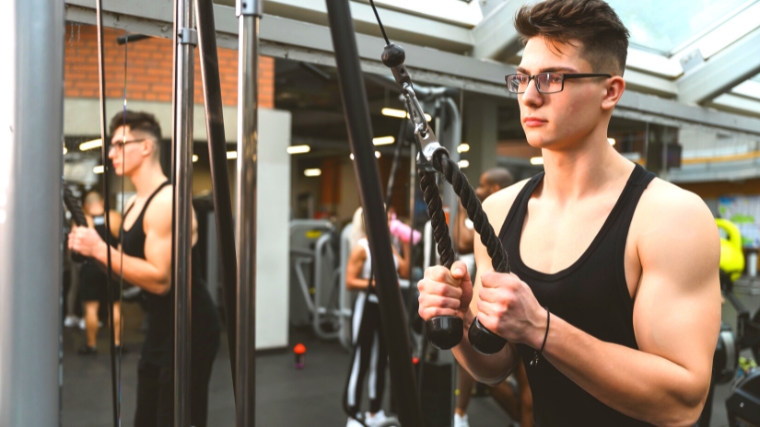
Particularly for the arms, you will have a unique “carrying angle” at your elbow, which is the angle that the forearm juts away from the upper arm. Cables allow you to customize your setup to account for these structurally-unique features, since your joints aren’t resisting the uniform downward pressure of gravity. This may help stave off any aches or pains that could arise from awkward free-weight movements.
They Help Stabilize Your Movement
Cables are a great middle-ground between machines, which are uniformly stabilized, and free weights, which are inherently unstable. While all training tools offer benefits, cables will land right in the middle.
Cables allow you to get a good degree of freedom to move and accommodate your unique anatomical or exercise-selection needs. However, they also provide greater stability than free weights, since the resistance is anchored to a specific point and will always pull in the direction of that point. Greater stability will keep you safer in positions such as the overhead triceps extension for more reliable progress.
They Are Easier to Train to Failure
Training close to failure is an undeniably-beneficial aspect of muscle building, but it can be hard to do in all conditions. Cables lend themselves well to a middle-repetition range of eight to 12 reps, which serves as a solid middle-ground.
If you lift too heavily, it may be more difficult to ensure your arms are performing the brunt of the work and you’re not passing the load off to larger muscles — think of heaving up a barbell curl with momentum from your hips and lower back.
Cables help you keep strict form and get the right muscle closer to failure, since the constant tension can offset the need for increased weight.
Anatomy of the Arms
Whether you’re a first-time gymgoer or a veteran weight room warrior, knowing all the major muscles of the arms can help you design the perfect workout.
Biceps Brachii
The biceps brachii are the classic “arm” muscles. They are located on the anterior (front) of the upper arm and are responsible for flexing your elbow.
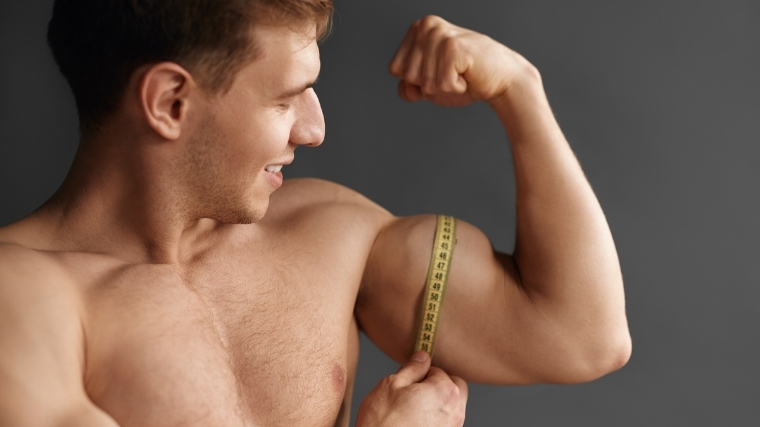
Most biceps curl exercises are going to stimulate the biceps brachii, with subtle changes to your arm angle helping to deliver a smidge more emphasis to either of the heads of the muscle. For the best results, target your biceps brachii by keeping your palm facing up the entire time.
Brachialis
The brachialis muscle sits underneath your biceps brachii. It actually is the primary muscle responsible for bending your elbow, since the brachialis doesn’t run all the way up your upper arm — it attaches between the forearm and the humerus.
However, you can’t really see your brachialis superficially. Training it (especially with a neutral, palms-facing-inward grip) will thicken the appearance of your arm overall, especially from the front, but it’s not a muscle you can flex in isolation.
Brachioradialis
The brachioradialis is a large muscle group of the forearm that also contributes to elbow flexion. In this sense, it is a part of your “biceps” muscle group, but also heavily contributes to the overall arm aesthetic by pumping up your forearm size.
Since it is located on the more lateral aspect of your forearm, curling motions that use a neutral grip or pronated grip (think hammer curls or reverse curls) will blast the brachioradialis.
Triceps Brachii
The triceps brachii comprise the big beefy backside of your arm. The triceps brachii are a combination of the medial, lateral, and long heads. They are all primarily responsible for elbow extension, with the long head also getting a bit of involvement in shoulder extension due to its attachment to the scapula.

Each of the triceps muscles attach to the back of your elbow area – meaning that they should all get stimulus from your triceps extensions or pushdowns. A special consideration should be made for the long head of triceps, which may get a bit more love from overhead triceps exercises because of its unique origin.
Bring Out the Big Guns
A good arm-only workout doesn’t have to be a once-in-a-while fitness indulgence. Many of your larger goals in the gym would benefit from having, well, larger arms. Moreover, you can perform one heck of an arm workout without leaving the cable tree.
These cable arm workouts are a fantastic addition to many training programs, and will grow along with your experience level. Complement any number of goals with some direct arm work and reap the benefits of a sick set of guns along with them.
References
1. Schoenfeld, B. J., Grgic, J., Van Every, D. W., & Plotkin, D. L. (2021). Loading Recommendations for Muscle Strength, Hypertrophy, and Local Endurance: A Re-Examination of the Repetition Continuum. Sports (Basel, Switzerland), 9(2), 32.
Featured Image: Miljan Zivkovic / Shutterstock